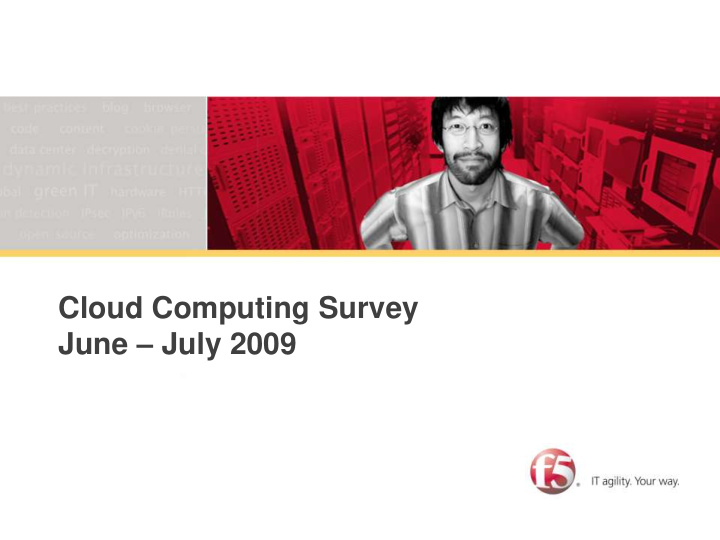



Cloud Computing Survey June – July 2009
2 Methodology • Applied Research performed survey • June 2009 • 250 responses – Enterprise IT (2,500 employees or more) – Manager, Director, VP, SVP (no CIOs) • Network • Information security • Architecture • Development
3 Key Findings • Confusion about cloud computing definition • Cloud computing has gained critical mass • Cloud computing is more than SaaS • Technology requirements for cloud computing • Influencers go beyond IT
4 Confusion about cloud computing definition Please rate the following six common cloud computing definitions using the following scale: There is nothing I agree with in this definition I agree with a few things, but mostly not This is about half right Almost there, but there are a few parts missing or incorrect Perfect! This definition nails it. 100% 17% 90% 24% 24% 24% 26% 35% 80% 70% 60% 46% 39% 40% 42% 42% 50% 33% 40% 30% 20% 22% 24% 22% 18% 20% 20% 8% 10% 6% 11% 7% 5% 6% 9% 7% 6% 6% 6% 4% 0% Cloud computing is a general A way to increase capacity or Cloud computing allows Cloud computing is a style of Cloud computing is on-demand A pay-per-use model for term for anything that involves add capabilities on the fly consumers and businesses to computing in which dynamically access to virtualized IT enabling available, convenient delivering hosted services over without investing in new use applications without scalable and often virtualized resources that are housed and on-demand network the internet infrastructure, training new installation and access their resources are provded as a outside of your own data access to a shared pool of personnel, or licensing new personal files at any computer service over the Internet. center, shared by others, configurable computing software with internet access Users need not have simple to use, paid for via resources that can be rapidly knowledge of, expertise in, or subscription, and accessed provisioned and released with control over the technology over the Web. minimal management effort or infrastructure in the "cloud" service provider interaction.
5 Cloud computing has gained critical mass • Private and public clouds have traction • Two thirds have dedicated budget for cloud computing • Budgets rising
6 Cloud computing is more than SaaS Rate the following components or technologies as they pertain to your understanding of Cloud Computing. Use the following scale: Never included in or required for cloud computing Usually not included in or required for cloud computing Sometimes included in or required for cloud computing Usually included in or required for cloud computing Always included in or required for cloud computing 100% 90% 24% 28% 31% 80% 70% 60% 30% 37% 50% 50% 40% 30% 28% 26% 20% 19% 10% 6% 5% 5% 5% 4% 2% 0% Platform as a Service (ex: Salesforce.com's SaaS (ex: Salesforce.com, NetSuite) Infrastructure as a Service (ex: Amazon Force.com, Google's App Engine) Compute Cloud, GoGrid, Bluelock)
7 Technology requirements for cloud computing • Access control (90%) • Network security (89%) • Virtualization (tie: 88%)
8 Influencers go beyond IT • Top public cloud decision makers – IT (45%), AppDev (41%), LOB stakeholders (41%) • Top private cloud decision makers – IT (45%), LOB stakeholders (36%), AppDev (24%)
9 Key Findings • Confusion about cloud computing definition • Cloud computing has gained critical mass • Cloud computing is more than SaaS • Technology requirements for cloud computing • Influencers go beyond IT
Recommend
More recommend